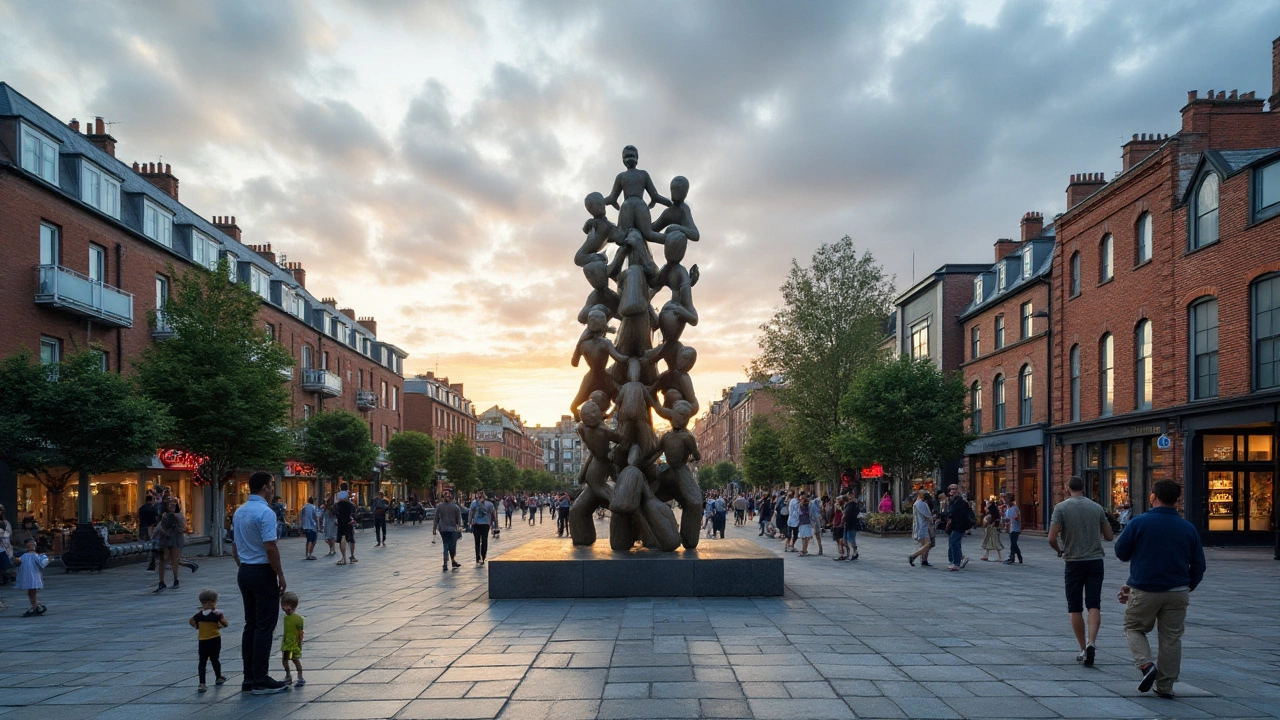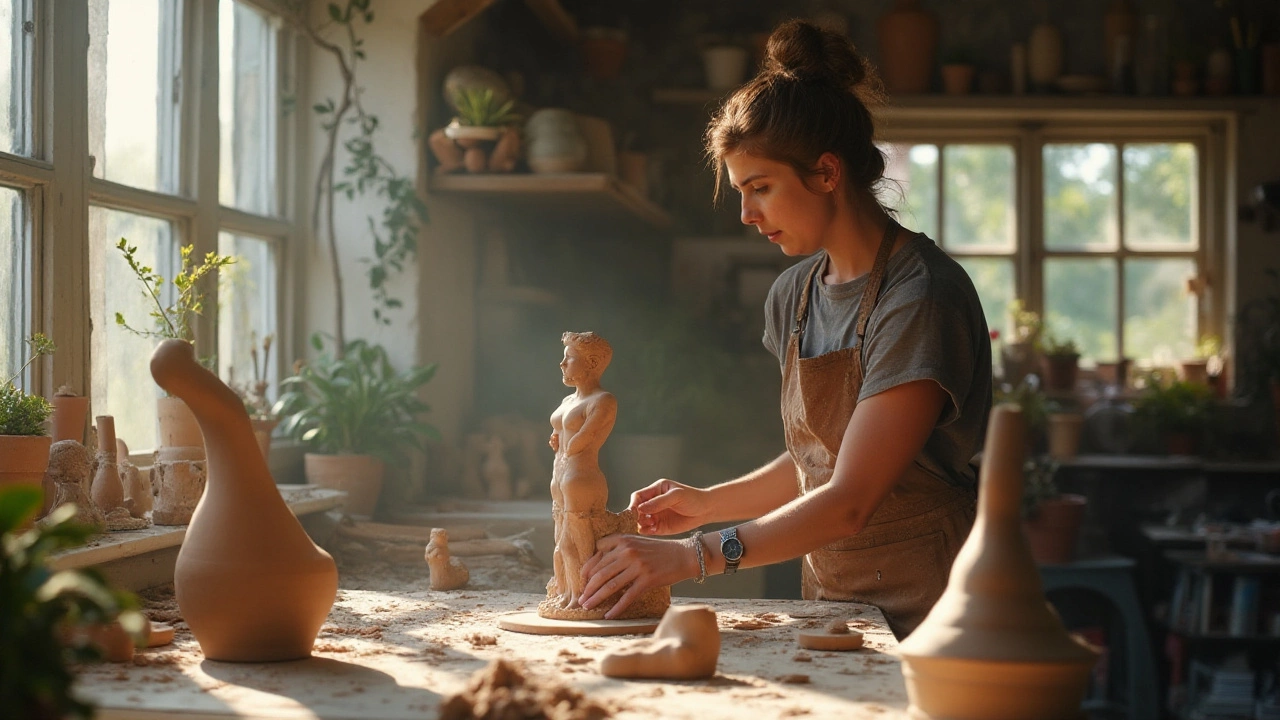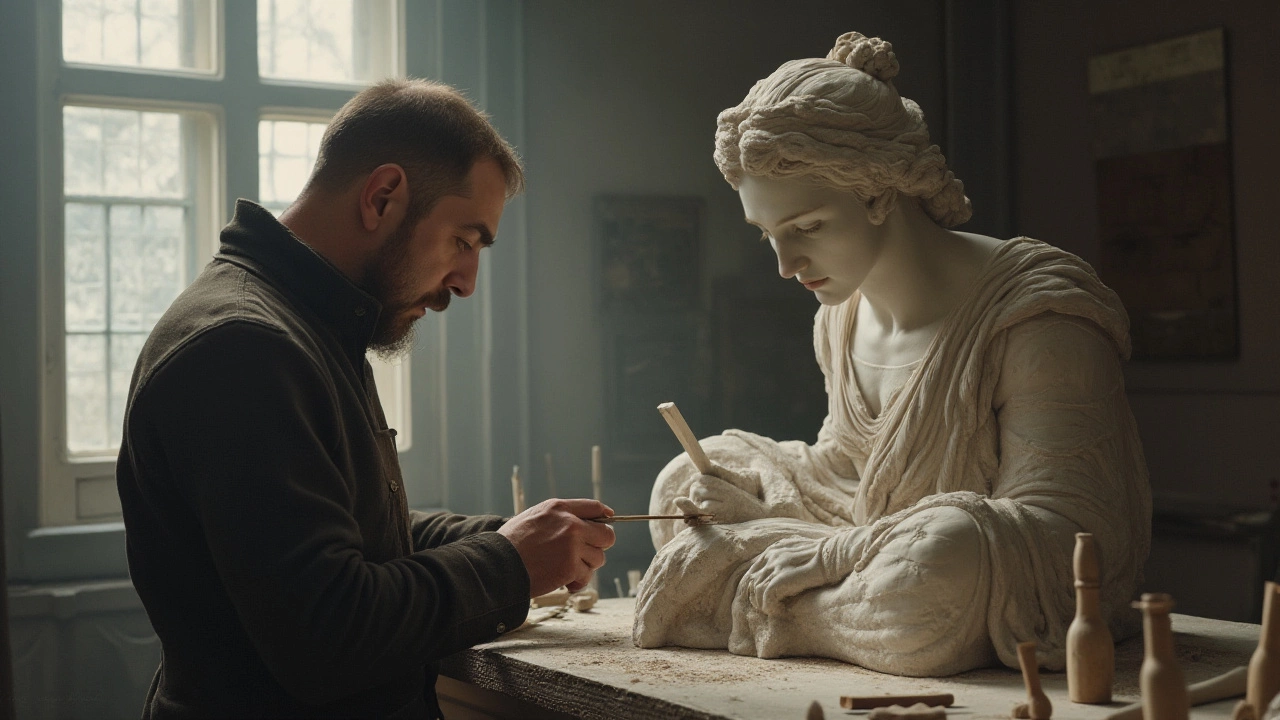Sculpture is more than just a blend of materials shaped into an intriguing form. It's a language through which artists express their imagination, capturing moments, emotions, or narratives that resonate deeply with viewers. Every sculpture tells a tale, and what sets it apart is the fusion of creativity and craftsmanship tailored by the sculptor’s hands.
As we explore the realm of sculptural art, it's important to recognize the multifaceted elements that contribute to its uniqueness. From the choice of material to the careful consideration of light and shadow, these works invite us to pause and consider their stories. In a world constantly moving towards the digital and intangible, sculpture remains a tactile reminder of the profound beauty of creation.
- The Role of Materials in Sculpture
- Innovative Techniques that Shape Art
- The Artist's Vision: From Conception to Reality
- Cultural Influences and Storytelling
- Scale and Space: Defining Presence
- The Interaction of Light and Shadow
The Role of Materials in Sculpture
When discussing sculpture, the materials used are often the first aspect that comes to mind. The choice of material lays the foundation upon which the entire artistic process is built. Each material brings with it its own distinct qualities, challenges, and potential for expression. From ancient times, artists have experimented with a vast array of materials, each selected for its aesthetic and practical properties. Stone, for instance, has a storied history stretching back to prehistoric carvings. Its durability meant that the messages and meanings sculpted from it endured through the ages, a testament to both the artist’s skill and the natural beauty of the material itself.
Metal, too, has played a significant role in the evolution of sculptural art. Bronze, known for its strength and ability to capture fine details, allowed artists to create dynamic and lifelike figures. The method of lost-wax casting, used since ancient Mesopotamia, revolutionized art by enabling the creation of intricate and expressive forms that were previously unattainable. Similarly, the industrial use of steel and aluminum brought about a new era of modernist sculpture. Artists like Richard Serra have utilized these materials to explore themes of space, weight, and balance, crafting monumental installations that challenge the viewer’s perception of scale and environment.
Wood is another material with a deep-rooted tradition in sculpture, offering a warm, organic presence contrasted with the cold hardness of metals. It symbolizes life and change, as it naturally ages and alters over time. The Japanese artist Masayuki Nagare is celebrated for his masterful blend of traditional and modern techniques in wood, each piece reflecting a meditative and serene quality deeply connected to nature. This highlights the artist’s ability to respect and enhance the inherent characteristics of their chosen medium.
"The material itself carries an idea, and by discovering characteristic forms in it, one discovers its spirit, and this spirit is the one to trigger a spiritual perception in the viewer." - Constantin Brâncuși
In recent decades, there has been a growing trend among artists to experiment with unconventional materials such as plastic, fabric, and even digital media. This shift is reflective of the ever-evolving definition of what constitutes a sculpture. Artists like Yayoi Kusama use soft materials and vibrant colors to create immersive, large-scale installations that invite interaction and invoke unique emotional responses. Found objects and recycled materials, too, are increasingly finding their way into contemporary sculpture, underscoring themes of sustainability and transformation.
Perhaps what makes the variety of materials in sculpture so fascinating is how they contribute to the unique identity of each piece. The artist’s choice is influenced by their personal vision, the intended context, and the interaction they wish to generate with the observer. Each material tells its own story, carrying with it a history and meaning that adds layers of depth to the artwork. Thus, understanding the role of materials in sculpture is essential for appreciating the full scope and beauty of this timeless art form.
Innovative Techniques that Shape Art
The evolution of sculpture art has been profoundly influenced by the innovative techniques artists employ to bring their visions to life. These techniques bridge the gap between traditional methods and contemporary creativity, offering a new lease of life to the timeless craft of sculpting. At the core of these innovations is an ever-curious artist who seeks to challenge conventions and expand the horizon of what is possible within the realm of sculpture.
One notable technique that has gained traction is the incorporation of digital technology. Digital sculpting software, such as ZBrush and Blender, allows sculptors to experiment with form and structure in a virtual environment before manifesting their ideas into physical art. This approach not only enhances precision but also provides novel opportunities for collaboration across geographical boundaries. Traditional boundaries are further pushed with the advent of 3D printing, which has revolutionized how sculptures are fabricated, enabling complex structures to be crafted with unparalleled intricacy.
Another innovative approach comes from integrating mixed media into sculpture. By combining materials like metal, glass, organic matter, and even light, artists can create dynamic pieces that shift perspectives and evoke layered interpretations. Kinetic sculptures, which incorporate movement, tap into this potential by transforming how viewers interact with the art. These sculptures respond to environmental stimuli, such as wind or light, inviting onlookers to experience it from multiple angles and notice subtle shifts over time.
Beyond materials and technology, process-based innovations are shaping modern art. The concept of 'process art' places emphasis on the creation process rather than the final product. This trend empowers artists to engage in a dialogue with their medium, exploring how alterations in technique can yield different emotional responses and visual outcomes. Here, the journey of creation becomes as compelling as the completed sculpture, inviting audiences to witness transformation in action.
Education plays a significant role in enabling these innovations. Art institutions around the world are incorporating courses that focus on new materials and technologies, fostering a culture of experimentation and research-driven practice. Partnerships between artists and scientists are also on the rise, leading to groundbreaking collaborations and pushing the boundaries of what's possible in sculpture. In her seminal work, 'Sculpture: Processes and Principles,' Rosalind Krauss emphasizes, "The marriage of science and art is perhaps one of the most profound possibilities for creative innovation in today's world."
These innovations reflect a symbiotic relationship between tradition and modernity, blending centuries-old techniques with cutting-edge advancements. As artists continue to embrace these evolving tools and methods, the resulting unique sculptures not only captivate but challenge the way we perceive the art form itself, suggesting that the journey forward holds even more opportunities for inventive expression.

The Artist's Vision: From Conception to Reality
An artist's vision is the bedrock upon which every great sculpture is built. It begins with an idea—a whisper of inspiration that grows into a profound conceptualization. This process is deeply personal, as the artist engages in a dialogue with their creative impulse, drawing from emotions, experiences, and the world around them. For sculptors, this vision is not limited to a two-dimensional sketch; it is an idea that they can practically hold, twist, and mold in their mind before their hands touch the chosen material.
During the early stages of conception, artists often engage in extensive research, sketches, and contemplations. They might explore existing works for inspiration or delve into cultural or historical contexts that might enrich their vision with depth and meaning. This is where each artist's unique signature begins to take shape. Artistic visionaries like Auguste Rodin believed that 'the artist must create a spark before he can make a fire and before art is born, the artist must be ready to be consumed by the fire of his own creation.' Indeed, this commitment to the creative blaze is what transforms a conceptual idea into an emotional reality.
Once the vision is clear, the journey from conception to reality involves the challenging yet exhilarating phase of execution. Here, skills meet spontaneity. Artists often test different techniques and experiment with raw materials until their vision aligns with the tangible. This phase requires not only technical prowess but also adaptability, as the medium itself can impose unexpected challenges or inspire new directions. This interplay between vision and material might lead to several iterations of work before achieving the envisioned masterpiece.
The realization of a sculpture also involves meticulous planning of physical space and structural integrity. Sculptors must ensure their piece harmonizes with its environment while standing strong against the forces of gravity and time. They consider how the sculpture will interact with light and shadow, which can dramatically alter its perception throughout the day and seasons. Some artists even build smaller models to test the design's feasibility before scaling up their work.
"Art is not what you see, but what you make others see," said Edgar Degas, emphasizing the importance of clarity in artistic expression.
Therefore, the completion of a sculpture is not merely about replicating the original vision. It is about adapting that vision, nurturing it, and allowing it to evolve throughout the creative process. Sculptors often find their work surprise them in unexpected ways, leading to realizations and revelations that were unforeseen in the initial phase. This journey from conception to physical form is what makes the artistic process both a challenge and a joy, resulting in a piece that is uniquely its own, pulsating with the life and whimsy that could only be brought forth by its creator.
Cultural Influences and Storytelling
Every creation in the world of sculpture is not only a testament to technical prowess but also a profound narrative woven from the cultural milieu of its time. Cultural influences have shaped sculptural art for centuries, turning it into both a historical document and a means of storytelling. Take, for instance, the classical sculptures of ancient Greece. These magnificent works reflect the Greek fascination with idealized human forms and were steeped in mythological narratives. Artists from that era such as Phidias and Praxiteles did not simply craft figures from marble; they immortalized gods and heroes, embedding them with stories and values that resonated throughout centuries.
Fast forward to the African continent, where sculptures like those from the Yoruba or Benin culture carry layers of historical importance and social commentary. African sculptures often embody spiritual and ancestral connections, with each piece serving as an emblem of identity and tradition. This is a testament to how deeply cultural roots run, influencing the artist’s choice in style, material, and symbolism. A sculptural artifact from Africa, for instance, might use wood or bronze not simply for their availability but due to their cultural significance, with each medium chosen deliberately to best convey the intended message and aesthetic.
"Art is not freedom from discipline, but disciplined freedom." - John F. Kennedy
In more contemporary settings, sculptural art continues to be an avenue where cultural dialogues and stories unfold. Take the works of Jeff Koons, whose sculptures often provide commentary on consumerism and modern society. While Koons’ pieces are visually striking, they invite deeper reflection on societal values, thereby carrying forward the storytelling tradition in a modern context. It's in this interplay of past and present where we see how culture continuously shapes and is shaped by art. We find this as artists navigate through modern issues, infusing their works with narratives that speak to the complexities of our current world.
When we consider the storytelling aspect, it is instructive to look at how sculptors interact with the spaces and communities around them. Public sculptures, in particular, are designed not just as stand-alone pieces but as dialogues with their surroundings. Works like the sculpture of "The Charging Bull" in New York exemplify this by symbolizing strength and resilience while engaging with the narrative of ambition and success inherent in the financial district. It encourages people stop and think, transcending mere artistic appreciation to become woven into the fabric of daily life.
Global Narratives in Sculpture
Across the globe, sculptors engage with cultural narratives in ways that are uniquely their own. From the serene simplicity of Japanese Zen gardens, which often feature meticulously placed rocks or abstract forms, to the elaborate religious sculptures found in Indian temples that depict deities and scenes from epic texts, there is an endless variety of storytelling styles. This diversity within sculptural art allows us to gain a window into the diverse human experience, providing a means to exchange stories across different cultures. The uniqueness of each sculpture becomes a powerful cultural marker, telling tales that often transcend their physical form to become part of a living tradition.

Scale and Space: Defining Presence
The interplay of scale and space in sculpture remains a cornerstone of what makes these artworks uniquely captivating. A sculpture's scale can command an entire landscape or nestle subtly in a more intimate setting, each instance defining its interaction with spectators and surroundings. The size of a piece doesn't just influence its physical presence; it imparts an emotional weight that can alter perception. Monumental sculptures, for instance, often evoke feelings of awe and grandeur, challenging individuals to ponder their own size and significance in the world. The strategic use of space around and within a piece plays a crucial role as well, inviting viewers to move around it, creating a dance between the ephemeral and the eternal. The balance between scale and space ensures that each artwork remains distinct.
One of the most renowned sculptures that effectively marries scale and space is Henry Moore's "Reclining Figure." Moore's sculptures are celebrated for their expansive forms that blend seamlessly with their environments. "Sculpture is an art of the open air," Moore insisted, emphasizing the importance of setting in experiencing the full impact of a work. This idea suggests that the surrounding space is as integral to its interpretation as the sculpture itself. The voids and forms within his masterpieces serve as passages for light and shadow, transforming the sculpture throughout the day and engaging with the viewer on multiple levels. This dynamic interaction brings a liveliness that static pieces often lack and maintains an audience's fascination.
In exploring sculptural scale, we must also consider Richard Serra's monumental steel installations. These towering structures transform the viewer's sense of balance and orientation, often leading them through labyrinthine paths where the scale of the work becomes a journey. His pieces famously do not provide a singular vantage point, but evolve as the observer navigates the space, enhancing the awareness of one's own movement. The immersive experience offered by these installations exemplifies a critical aspect of three-dimensional art — the physical engagement with size and space resulting in personal discovery. Intrinsically tied to the concept of presence is the idea that each passerby leaves with a unique impression, influenced heavily by their interaction with the sculpture.
"The spaces we inhabit can only be defined when experienced," wrote Richard Serra, underscoring the significance of engagement. This concept shifts focus from mere observation to active participation, leading to a profound appreciation of the textures, shapes, and the presence a sculpture embodies.
The interaction between scale and space provokes discussions stretching beyond the physical. It opens dialogues about human dimensions versus their creations: do larger structures assert dominance or invite introspection? This nuanced relationship reveals that in the world of sculpture, size and surrounding space are not mere artist choices but communicative tools that convey messages transcending the material form. As individuals traverse around or through these pieces, they come to understand that scale and space define not just a sculpture's presence, but its essence.
The Interaction of Light and Shadow
In the world of sculpture, the play of light and shadow is as integral to the piece as the materials used to create it. The way light falls upon a sculpture can transform its appearance, highlighting certain aspects while shrouding others in mystery. This dynamic relationship adds depth and complexity, inviting the viewer to see the art from different perspectives. Artists meticulously consider how light interacts with their work, often conducting studies at different times of the day to determine the best lighting for display. A sculpture might gleam under direct sunlight, casting long, defined shadows, or take on an ethereal quality under soft, diffused light.
Sculptors often take advantage of natural and artificial lighting to evoke certain emotions or tell specific stories through their pieces. For example, in ancient Greece, sculptures were intentionally positioned in sacred spaces to catch the light of dawn or dusk, creating a divine or otherworldly effect that accentuated religious reverence and cultural significance. Similarly, modern sculptors may design their work for specific exhibitions with the lighting in mind, crafting pieces that dramatically change appearance under different conditions.
"The true beauty of sculpture lies in its ability to capture light and cast shadows, telling a story through every beam and every shade." - Renowned sculptor Antony Gormley
Some materials are chosen for their reflective qualities, such as polished metals or glass, which can create dazzling displays of light. Other materials, like stone or wood, might absorb light, creating subtle, more contemplative effects. Artists employ techniques like carving, polishing, or texturing surfaces to manipulate how light interacts with their work. This manipulation can enhance the spectators' experience, making them perceive the art in ways that constantly change with their position and the time of day.
In addition to considering how light affects the visual impression of a piece, sculptors also think about shadows and their potential to extend the work's reach beyond its material form. Shadows become an integral part of the sculpture, extending the narrative by adding another layer of intrigue. A shadow might accentuate a particular shape or form, or it could merge with the environment to create an installation that appears to shift and move over time. Shadow art, a fascinating subgenre, involves precise placement of lights and objects to cast recognizable figures in the shadows, demonstrating the sculptor's mastery over these unseen elements.
Many sculptures are designed with both interior and exterior spaces in mind, requiring artists to adapt their vision based on whether natural sunlight or artificial gallery lighting is used. In a typical sculpture garden, for instance, pieces are positioned to take full advantage of the sun's natural arc, while indoor installations may use spotlights or ambient lighting to accentuate their contours. Artists often collaborate with lighting designers to achieve the desired effect, crafting a final presentation that encompasses every detail from shadows cast on the floor to reflections in nearby surfaces.

